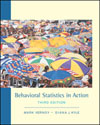 |  Behavioral Statistics in Action, 3/e Mark W. Vernoy,
Palomar College
Diana J. Kyle,
Fullerton College
The Normal Curve
Glossary
| A normal curve | is the graphic description of the normal distribution. Since all scores are represented under the normal curve, the entire area is equal to 1. Thus, normal curve can be envisioned as a picture of the proportion of the total number of scores lying under the curve. While normal curves can assume various shapes, they all share the following five common characteristics: 1) The curve is bell-shaped and symmetrical. 2) The mean, median, and mode are all equal. 3) The highest frequency is in the middle of the curve. 4) The frequency gradually tapers off as the scores approach the ends of the curve. 5) The curve approaches, but never meets, the abscissa at both the high and low ends.
|  |  |  | | A percentile | is the raw score that has a percentage of scores falling below it.
|  |  |  | | Quartiles | are the raw scores that divide the distribution into four equal quarters.
|  |  |  | | The normal distribution | is the theoretical distribution of scores with most of the scores clustered around the middle (mean, median, mode are equal) and the frequency of the scores gradually lessening on either side. When graphed, the normal distribution is referred to as the normal curve.
|
|



 2002 McGraw-Hill Higher Education
2002 McGraw-Hill Higher Education

 2002 McGraw-Hill Higher Education
2002 McGraw-Hill Higher Education